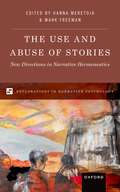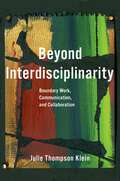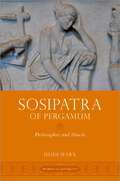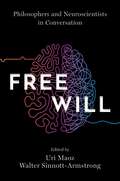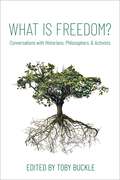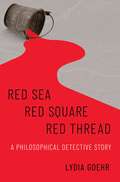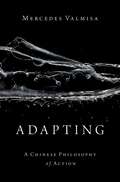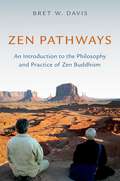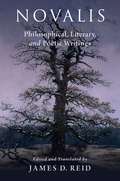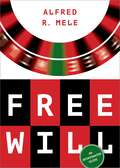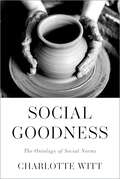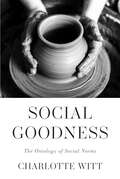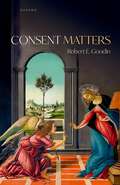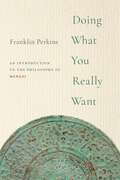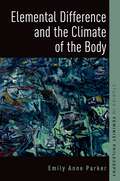- Table View
- List View
The Use and Abuse of Stories: New Directions in Narrative Hermeneutics (EXPLORATIONS IN NARRATIVE PSYCH SERIES)
by Hanna Meretoja and Mark FreemanNarrative practice has come under attack in the current "post-truth" era. In fact, many associate "narrative hermeneutics"--the field of inquiry concerned with reflection on the meaning and interpretation of stories--directly with this putative movement beyond truth. Challenging this view, The Use and Abuse of Stories argues that this broad arena of inquiry instead serves as a vitally important vehicle for addressing and redressing the social and political problems at hand. Hanna Meretoja and Mark Freeman have gathered an interdisciplinary group of esteemed authors to explore how interpretation is relevant to current discussions in narrative studies and to the broader debate that revolves around issues of truth, facts, and narrative. The contributions turn to the tradition of narrative hermeneutics to emphasize that narrative is a cultural meaning-making practice that is integral to how we make sense of who we are and who we could be. Addressing topics ranging from the dangers of political narratives to questions of truth in medical and psychiatric practice, this volume shows how narrative hermeneutics contributes to topical debates both in interdisciplinary narrative studies and in the current cultural and political situation in which issues of truth have gained new urgency.
Beyond Interdisciplinarity: Boundary Work, Communication, and Collaboration
by Julie Thompson KleinBeyond Interdisciplinarity examines the broadening meaning of core concept across academic disciplines and other forms of knowledge. In this book, Associate Editor of The Oxford Handbook of Interdisciplinarity and internationally recognized scholar Julie Thompson Klein depicts the heterogeneity and boundary work of inter- and trans-disciplinarity in a conceptual framework based on an ecology of spatializing practices in transaction spaces, including trading zones and communities of practice. The book includes both "crossdisciplinary" work (encompassing multi-, inter-, and trans-disciplinary forms) as well as "cross-sector" work (spanning disciplines, fields, professions, government and industry, and communities). The first section of the book defines and explains boundary work, discourses of interdisciplinarity, and the nature of interdisciplinary fields. In the second section, Klein examines dynamics of working across disciplines, including communication, collaboration, and learning with concrete examples and lessons from research projects and programs that transcend traditional fields. The closing chapter examines reasons for failure and success then presents gateways to literature and other resources. Throughout the book, Klein emphasizes the roles of contextualization and historical change while factoring in the shifting relationship of disciplinarity and interdisciplinarity, ascendancy of transdisciplinarity, and intersections with other constructs including Mode 2 knowledge production, convergence, team science, and postdisciplinarity. The conceptual framework she provides also includes the role of boundary objects, agents, and organizations in brokering differences and creating for platforms for change. Klein further explains why translation, interlanguage, and a communication boundary space are vital to achieving intersubjectivity and collective identity. They foster not only pragmatics of negotiation and integration but also reflexivity, transactivity, and co-production of knowledge with stakeholders beyond the academy. Rhetorics of holism and synthesis compete with instrumentalities of problem solving and transgressive critiques. However, typical warrants today include complexity, contextualization, collaboration, and socially-robust knowledge. Crossing boundaries remains complex, but this book guides readers through the density of pertinent literature while expanding understandings of crossdisciplinary and cross-sector work.
Beyond Interdisciplinarity: Boundary Work, Communication, and Collaboration
by Julie Thompson KleinBeyond Interdisciplinarity examines the broadening meaning of core concept across academic disciplines and other forms of knowledge. In this book, Associate Editor of The Oxford Handbook of Interdisciplinarity and internationally recognized scholar Julie Thompson Klein depicts the heterogeneity and boundary work of inter- and trans-disciplinarity in a conceptual framework based on an ecology of spatializing practices in transaction spaces, including trading zones and communities of practice. The book includes both "crossdisciplinary" work (encompassing multi-, inter-, and trans-disciplinary forms) as well as "cross-sector" work (spanning disciplines, fields, professions, government and industry, and communities). The first section of the book defines and explains boundary work, discourses of interdisciplinarity, and the nature of interdisciplinary fields. In the second section, Klein examines dynamics of working across disciplines, including communication, collaboration, and learning with concrete examples and lessons from research projects and programs that transcend traditional fields. The closing chapter examines reasons for failure and success then presents gateways to literature and other resources. Throughout the book, Klein emphasizes the roles of contextualization and historical change while factoring in the shifting relationship of disciplinarity and interdisciplinarity, ascendancy of transdisciplinarity, and intersections with other constructs including Mode 2 knowledge production, convergence, team science, and postdisciplinarity. The conceptual framework she provides also includes the role of boundary objects, agents, and organizations in brokering differences and creating for platforms for change. Klein further explains why translation, interlanguage, and a communication boundary space are vital to achieving intersubjectivity and collective identity. They foster not only pragmatics of negotiation and integration but also reflexivity, transactivity, and co-production of knowledge with stakeholders beyond the academy. Rhetorics of holism and synthesis compete with instrumentalities of problem solving and transgressive critiques. However, typical warrants today include complexity, contextualization, collaboration, and socially-robust knowledge. Crossing boundaries remains complex, but this book guides readers through the density of pertinent literature while expanding understandings of crossdisciplinary and cross-sector work.
SOSIPATRA OF PERGAMUM WIA C: Philosopher and Oracle (Women in Antiquity)
by Heidi MarxThe story of Sosipatra of Pergamum (4th century C.E.) as told by her biographer, Eunapius of Sardis in his Lives of the Philosophers and Sophists, is a remarkable tale. It is the story of an elite young girl from the area of Ephesus, who was educated by traveling oracles (daemons), and who grew up to lead her own philosophy school on the west coast of Asia Minor. She was also a prophet of sorts, channeling divine messages to her students, family, and friends, and foretelling the future. Sosipatra of Pergamum is the first sustained, book length attempt to tell the story of this mysterious woman. It presents a rich contextualization of the brief and highly fictionalized portrait provided by Eunapius. In doing so, the book explores the cultural and political landscape of late ancient Asia Minor, especially the areas around Ephesus, Pergamum, Sardis, and Smyrna. It also discusses moments in Sosipatra's life for what they reveal more generally about women's lives in Late Antiquity in the areas of childhood, education, family, household, motherhood, widowhood, and professional life. Her career sheds light on late Roman Platonism, its engagement with religion, ritual, and "magic," and the role of women in this movement. By thoroughly examining the ancient evidence, Heidi Marx recovers a hidden yet important figure from the rich intellectual traditions of the Roman Near East.
Free Will: Philosophers and Neuroscientists in Conversation
What is free will? Can it exist in a determined universe? How can we determine who, if anyone, possesses it? Philosophers have debated the extent of human free will for millennia. In recent decades neuroscientists have joined the fray with questions of their own. Which neural mechanisms could enable conscious control of action? What are intentional actions? Do contemporary developments in neuroscience rule out free will or, instead, illuminate how it works? Over the past few years, neuroscientists and philosophers have increasingly come to understand that both fields can make substantive contributions to the free-will debate, so working together is the best path forward to understanding whether, when, and how our choices might be free This book contains thirty bidirectional exchanges between neuroscientists and philosophers that focus on the most critical questions in the neurophilosophy of free will. It mimics a lively, interdisciplinary conference, where experts answer questions and follow-up questions from the other field, helping each discipline to understand how the other thinks and works. Each chapter is concise and accessible to non-experts-free from disciplinary jargon and highly technical details-but also employs thorough and up-to-date research from experts in the field. The resulting collection should be useful to anyone who wants to get up to speed on the most fundamental issues in the rising field of the neurophilosophy of free will. It will interest experts from philosophy or neuroscience who want to learn about the other discipline, students in courses on a host of related topics, and lay readers who are fascinated by these profound issues.
Free Will: Philosophers and Neuroscientists in Conversation
by Uri Maoz and Walter Sinnott- ArmstrongWhat is free will? Can it exist in a determined universe? How can we determine who, if anyone, possesses it? Philosophers have debated the extent of human free will for millennia. In recent decades neuroscientists have joined the fray with questions of their own. Which neural mechanisms could enable conscious control of action? What are intentional actions? Do contemporary developments in neuroscience rule out free will or, instead, illuminate how it works? Over the past few years, neuroscientists and philosophers have increasingly come to understand that both fields can make substantive contributions to the free-will debate, so working together is the best path forward to understanding whether, when, and how our choices might be free This book contains thirty bidirectional exchanges between neuroscientists and philosophers that focus on the most critical questions in the neurophilosophy of free will. It mimics a lively, interdisciplinary conference, where experts answer questions and follow-up questions from the other field, helping each discipline to understand how the other thinks and works. Each chapter is concise and accessible to non-experts-free from disciplinary jargon and highly technical details-but also employs thorough and up-to-date research from experts in the field. The resulting collection should be useful to anyone who wants to get up to speed on the most fundamental issues in the rising field of the neurophilosophy of free will. It will interest experts from philosophy or neuroscience who want to learn about the other discipline, students in courses on a host of related topics, and lay readers who are fascinated by these profound issues.
What is Freedom?: Conversations with Historians, Philosophers, and Activists
by Toby BuckleAll of us feel the presence of freedom in how we conceptualize, interact with, and accept or reject our political and economic institutions. But what is it? Where did this value come from? How should we describe it in theory? How should we pursue it in practice? For the past two years activist Toby Buckle, host of the popular Political Philosophy Podcast, has interviewed many of the world's leading historians, philosophers, and activists to try and understand freedom's meanings and applications in the modern world. Through a series of accessible interviews this volume introduces the reader to many of the contemporary ideas and debates about freedom from a wide range of perspectives in an engaging conversational presentation. Featuring a foreword by Cécile Fabre, the book includes contributions from Elizabeth Anderson, Mary Frances Berry, Ian Dunt, Michael Freeden, Nancy Hirschmann, Omar Khan, Dale Martin, Orlando Patterson, Phillip Pettit, John Skorupski, Peter Tatchell, and Zephyr Teachout.
What is Freedom?: Conversations with Historians, Philosophers, and Activists
by Toby BuckleAll of us feel the presence of freedom in how we conceptualize, interact with, and accept or reject our political and economic institutions. But what is it? Where did this value come from? How should we describe it in theory? How should we pursue it in practice? For the past two years activist Toby Buckle, host of the popular Political Philosophy Podcast, has interviewed many of the world's leading historians, philosophers, and activists to try and understand freedom's meanings and applications in the modern world. Through a series of accessible interviews this volume introduces the reader to many of the contemporary ideas and debates about freedom from a wide range of perspectives in an engaging conversational presentation. Featuring a foreword by Cécile Fabre, the book includes contributions from Elizabeth Anderson, Mary Frances Berry, Ian Dunt, Michael Freeden, Nancy Hirschmann, Omar Khan, Dale Martin, Orlando Patterson, Phillip Pettit, John Skorupski, Peter Tatchell, and Zephyr Teachout.
Red Sea-Red Square-Red Thread: A Philosophical Detective Story
by Lydia GoehrA profoundly original philosophical detective story tracing the surprising history of an anecdote ranging across centuries of traditions, disciplines, and ideas Red Sea-Red Square-Red Thread is a work of passages taken, written, painted, and sung. It offers a genealogy of liberty through a micrology of wit. It follows the long history of a short anecdote. Commissioned to depict the biblical passage through the Red Sea, a painter covered over a surface with red paint, explaining thereafter that the Israelites had already crossed over and that the Egyptians were drowned. Clearly, not all you see is all you get. Who was the painter and who the first teller of the tale? Designed as a philosophical detective story, Red Sea-Red Square-Red Thread follows the extraordinary number of thinkers and artists who have used the Red Sea anecdote to make so much more than a merely anecdotal point. Leading the large cast are the philosophers, Arthur Danto and Søren Kierkegaard, the poet and playwright, Henri Murger, the opera composer, Giacomo Puccini, and the painter and print-maker, William Hogarth. Strange companions perhaps, until their use of the anecdote is shown as working its extraordinary passage through so many cosmopolitan cities of art and capital. What about the anecdote brings Danto's philosophy of art into conversation with Kierkegaard's stages on life's way, with Murger and Puccini's la vie de bohème, and with Hogarth's modern moral pictures? The book explores narratives of emancipation in philosophy, theology, politics, and the arts. What has the passage of the Israelites to do with the Egyptians who, by many gypsy names, came to be branded as bohemians when arriving in France from the German lands of Bohemia? What have Moses and monotheism to do with the history of monism and the monochrome? And what sort of thread connects a sea to a square when each is so purposefully named red?
Red Sea-Red Square-Red Thread: A Philosophical Detective Story
by Lydia GoehrA profoundly original philosophical detective story tracing the surprising history of an anecdote ranging across centuries of traditions, disciplines, and ideas Red Sea-Red Square-Red Thread is a work of passages taken, written, painted, and sung. It offers a genealogy of liberty through a micrology of wit. It follows the long history of a short anecdote. Commissioned to depict the biblical passage through the Red Sea, a painter covered over a surface with red paint, explaining thereafter that the Israelites had already crossed over and that the Egyptians were drowned. Clearly, not all you see is all you get. Who was the painter and who the first teller of the tale? Designed as a philosophical detective story, Red Sea-Red Square-Red Thread follows the extraordinary number of thinkers and artists who have used the Red Sea anecdote to make so much more than a merely anecdotal point. Leading the large cast are the philosophers, Arthur Danto and Søren Kierkegaard, the poet and playwright, Henri Murger, the opera composer, Giacomo Puccini, and the painter and print-maker, William Hogarth. Strange companions perhaps, until their use of the anecdote is shown as working its extraordinary passage through so many cosmopolitan cities of art and capital. What about the anecdote brings Danto's philosophy of art into conversation with Kierkegaard's stages on life's way, with Murger and Puccini's la vie de bohème, and with Hogarth's modern moral pictures? The book explores narratives of emancipation in philosophy, theology, politics, and the arts. What has the passage of the Israelites to do with the Egyptians who, by many gypsy names, came to be branded as bohemians when arriving in France from the German lands of Bohemia? What have Moses and monotheism to do with the history of monism and the monochrome? And what sort of thread connects a sea to a square when each is so purposefully named red?
Adapting: A Chinese Philosophy of Action
by Mercedes ValmisaIf you are from the West, it is likely that you normally assume that you are a subject who relates to objects and other subjects through actions that spring purely from your own intentions and will. Chinese philosophers, however, show how mistaken this conception of action is. Philosophy of action in Classical China is radically different from its counterpart in the Western philosophical narrative. While the latter usually assumes we are discrete individual subjects with the ability to act or to effect change, Classical Chinese philosophers theorize that human life is embedded in endless networks of relationships with other entities, phenomena, and socio-material contexts. These relations are primary to the constitution of the person, and hence acting within an early Chinese context is interacting and co-acting along with others, human or nonhuman. This book is the first monograph dedicated to the exploration and rigorous reconstruction of an extraordinary strategy for efficacious relational action devised by Classical Chinese philosophers, one which attempts to account for the interdependent and embedded character of human agency-what Mercedes Valmisa calls "adapting" or "adaptive agency" (yin) As opposed to more unilateral approaches to action conceptualized in the Classical Chinese corpus, such as forceful and prescriptive agency, adapting requires heightened self- and other-awareness, equanimity, flexibility, creativity, and response. These capacities allow the agent to "co-raise" courses of action ad hoc: unique and temporary solutions to specific, non-permanent, and non-generalizable life problems. Adapting is one of the world's oldest philosophies of action, and yet it is shockingly new for contemporary audiences, who will find in it an unlikely source of inspiration to cope with our current global problems. This book explores the core conception of adapting both on autochthonous terms and by cross-cultural comparison, drawing on the European and Analytic philosophical traditions as well as on scholarship from other disciplines. Valmisa exemplifies how to build meaningful philosophical theories without treating individual books or putative authors as locations of stable intellectual positions, opening brand-new topics in Chinese and comparative philosophy.
Adapting: A Chinese Philosophy of Action
by Mercedes ValmisaIf you are from the West, it is likely that you normally assume that you are a subject who relates to objects and other subjects through actions that spring purely from your own intentions and will. Chinese philosophers, however, show how mistaken this conception of action is. Philosophy of action in Classical China is radically different from its counterpart in the Western philosophical narrative. While the latter usually assumes we are discrete individual subjects with the ability to act or to effect change, Classical Chinese philosophers theorize that human life is embedded in endless networks of relationships with other entities, phenomena, and socio-material contexts. These relations are primary to the constitution of the person, and hence acting within an early Chinese context is interacting and co-acting along with others, human or nonhuman. This book is the first monograph dedicated to the exploration and rigorous reconstruction of an extraordinary strategy for efficacious relational action devised by Classical Chinese philosophers, one which attempts to account for the interdependent and embedded character of human agency-what Mercedes Valmisa calls "adapting" or "adaptive agency" (yin) As opposed to more unilateral approaches to action conceptualized in the Classical Chinese corpus, such as forceful and prescriptive agency, adapting requires heightened self- and other-awareness, equanimity, flexibility, creativity, and response. These capacities allow the agent to "co-raise" courses of action ad hoc: unique and temporary solutions to specific, non-permanent, and non-generalizable life problems. Adapting is one of the world's oldest philosophies of action, and yet it is shockingly new for contemporary audiences, who will find in it an unlikely source of inspiration to cope with our current global problems. This book explores the core conception of adapting both on autochthonous terms and by cross-cultural comparison, drawing on the European and Analytic philosophical traditions as well as on scholarship from other disciplines. Valmisa exemplifies how to build meaningful philosophical theories without treating individual books or putative authors as locations of stable intellectual positions, opening brand-new topics in Chinese and comparative philosophy.
Zen Pathways: An Introduction to the Philosophy and Practice of Zen Buddhism
by Bret W. DavisThis book offers an in-depth introduction to the philosophy and practice of Zen Buddhism. Bret Davis explores the philosophical implications of Zen teachings and koans, comparing and contrasting these with other Asian as well as Western religions and philosophies. He relates traditional Zen teachings and practices to our twenty-first century lives. In addition to being a scholarly and philosophical introduction to Zen, the book provides concrete instructions for beginning a practice of Zen meditation. Its twenty-four chapters treat such philosophical topics as the self, nature, art, morality, and language, as well as basic Buddhist teachings such as the middle way and karma. Davis introduces the Zen based philosophies of the Kyoto School and also engages in interreligious dialogue with Christianity and other religions, as well as with other schools of Buddhism. The concluding chapter reviews the path of Zen practice and enlightenment by way of commenting on the beloved Zen classic, The Ten Oxherding Pictures. The book can be read in its entirety as a coherently organized introduction to the philosophy and practice of Zen, or chapters can be read independently according to the reader's specific interests.
Zen Pathways: An Introduction to the Philosophy and Practice of Zen Buddhism
by Bret W. DavisThis book offers an in-depth introduction to the philosophy and practice of Zen Buddhism. Bret Davis explores the philosophical implications of Zen teachings and koans, comparing and contrasting these with other Asian as well as Western religions and philosophies. He relates traditional Zen teachings and practices to our twenty-first century lives. In addition to being a scholarly and philosophical introduction to Zen, the book provides concrete instructions for beginning a practice of Zen meditation. Its twenty-four chapters treat such philosophical topics as the self, nature, art, morality, and language, as well as basic Buddhist teachings such as the middle way and karma. Davis introduces the Zen based philosophies of the Kyoto School and also engages in interreligious dialogue with Christianity and other religions, as well as with other schools of Buddhism. The concluding chapter reviews the path of Zen practice and enlightenment by way of commenting on the beloved Zen classic, The Ten Oxherding Pictures. The book can be read in its entirety as a coherently organized introduction to the philosophy and practice of Zen, or chapters can be read independently according to the reader's specific interests.
Novalis: Philosophical, Literary, and Poetic Writings
Despite his short life, Friedrich von Hardenberg (otherwise known as Novalis, 1772-1801) was one of the most original and polymathic figures of the early Romantic movement in Germany. Novalis: Philosophical, Literary, and Poetic Writings assembles, for the first time in English, translations of Novalis's published philosophical works, a large share of his surviving philosophical notes and fragments, his two unfinished novels (The Disciples at Sa?s and Heinrich von Ofterdingen), and the Hymns to the Night. Unlike some of his contemporaries, Novalis not only theorized about art and its place in both the world of everyday human life and the universe of philosophical discourse but was himself a consummate artist in his own right. This unique edition of Novalis's writings in English allows readers to track issues and themes throughout his short but productive career as a budding philosopher in the post-Kantian tradition, as a philosophical novelist, and as a poet of the first rank. Readers interested in Novalis's views on philosophy, art, morality, politics, and religion, and how positions in each of these areas might be unified in single, overarching vision of reality, will find the present translation an essential guide.
Novalis: Philosophical, Literary, and Poetic Writings
by James D. ReidDespite his short life, Friedrich von Hardenberg (otherwise known as Novalis, 1772-1801) was one of the most original and polymathic figures of the early Romantic movement in Germany. Novalis: Philosophical, Literary, and Poetic Writings assembles, for the first time in English, translations of Novalis's published philosophical works, a large share of his surviving philosophical notes and fragments, his two unfinished novels (The Disciples at Sa?s and Heinrich von Ofterdingen), and the Hymns to the Night. Unlike some of his contemporaries, Novalis not only theorized about art and its place in both the world of everyday human life and the universe of philosophical discourse but was himself a consummate artist in his own right. This unique edition of Novalis's writings in English allows readers to track issues and themes throughout his short but productive career as a budding philosopher in the post-Kantian tradition, as a philosophical novelist, and as a poet of the first rank. Readers interested in Novalis's views on philosophy, art, morality, politics, and religion, and how positions in each of these areas might be unified in single, overarching vision of reality, will find the present translation an essential guide.
Free Will: An Opinionated Guide
by Alfred R. MeleFree Will: An Opinionated Guide offers a clear and straightforward introduction to a vexing topic, from an internationally recognized authority on free will. What did you do a moment ago? What will you do after you read this? Are you deciding as we speak, or is something else going on in your brain or elsewhere in your body that is determining your actions? Stopping to think this way can freeze us in our tracks. A lot in the world feels far beyond our control--the last thing we need is to question whether we make our own choices in the way we usually assume we do. Questions about free will are so major and consequential that we may prefer not to think about them at all, lest we feel completely lost and unsure of everything we thought we knew! Free will is certainly important, but it does not need to be daunting. Free Will: An Opinionated Guide offers a clear and straightforward introduction to this vexing topic. Drawing on decades of extensive research in philosophy, neuroscience, and psychology, internationally recognized authority on free will Alfred R. Mele explains and explores the most prominent theories, puzzles, and arguments about free will, all the while presenting his own distinctive take on the topic. Mele's use of attention-grabbing thought experiments brings deep philosophical issues to life. He tackles the questions already on readers' minds and some they will encounter for the first time, on topics like determinism, neuroscience, and control. Whether this is the only book on free will you will read, or just the beginning of a deeper investigation, you will never think about free will, or the decisions you believe you're making, in the same ways again.
Free Will: An Opinionated Guide
by Alfred R. MeleFree Will: An Opinionated Guide offers a clear and straightforward introduction to a vexing topic, from an internationally recognized authority on free will. What did you do a moment ago? What will you do after you read this? Are you deciding as we speak, or is something else going on in your brain or elsewhere in your body that is determining your actions? Stopping to think this way can freeze us in our tracks. A lot in the world feels far beyond our control--the last thing we need is to question whether we make our own choices in the way we usually assume we do. Questions about free will are so major and consequential that we may prefer not to think about them at all, lest we feel completely lost and unsure of everything we thought we knew! Free will is certainly important, but it does not need to be daunting. Free Will: An Opinionated Guide offers a clear and straightforward introduction to this vexing topic. Drawing on decades of extensive research in philosophy, neuroscience, and psychology, internationally recognized authority on free will Alfred R. Mele explains and explores the most prominent theories, puzzles, and arguments about free will, all the while presenting his own distinctive take on the topic. Mele's use of attention-grabbing thought experiments brings deep philosophical issues to life. He tackles the questions already on readers' minds and some they will encounter for the first time, on topics like determinism, neuroscience, and control. Whether this is the only book on free will you will read, or just the beginning of a deeper investigation, you will never think about free will, or the decisions you believe you're making, in the same ways again.
Social Goodness: The Ontology of Social Norms
by Charlotte WittWe are all immersed in a sea of social norms, but they are sometimes tricky to observe with any clarity. They are often invisible to us and emerge only when they are not observed. Social norms are important to understand because they are both limiting of our freedom, such as gendered and racialized norms, and at the same time the very conditions of our agency. Social Goodness presents an original, externalist answer to the question of the source or origin of social role normativity. Rather than grounding social normativity in the attitudes of persons, the book argues for an externalism that roots social role normativity in the social world itself: in its positions, institutions, and larger architecture. The core insight of externalism is that the function or structural feature of an enterprise or activity can bring with it normative demands quite independently of the attitudes of those who engage with it. According to the artisanal model, just as a carpenter, ceramicist, or chef is responsive to and evaluable under a set of artisanal norms or techniques, so too is a mother and or an academic or a President. The source of normativity is this technique or expertise, independent of the preferences, endorsements, or recognitive attitudes of individuals. The artisanal model for social role normativity has resources to explain both the "stickiness" or persistence of social norms and our ability to criticize existing norms and to engage in normative self-creation--to create new normative selves. The artisanal model also has resources to capture and express the social situatedness, locality, and materiality of social roles. The relational ontology of social roles, implicit in the artisanal model, provides a useful frame to consider both hierarchical and oppressive social relations.
Social Goodness: The Ontology of Social Norms
by Charlotte WittWe are all immersed in a sea of social norms, but they are sometimes tricky to observe with any clarity. They are often invisible to us and emerge only when they are not observed. Social norms are important to understand because they are both limiting of our freedom, such as gendered and racialized norms, and at the same time the very conditions of our agency. Social Goodness presents an original, externalist answer to the question of the source or origin of social role normativity. Rather than grounding social normativity in the attitudes of persons, the book argues for an externalism that roots social role normativity in the social world itself: in its positions, institutions, and larger architecture. The core insight of externalism is that the function or structural feature of an enterprise or activity can bring with it normative demands quite independently of the attitudes of those who engage with it. According to the artisanal model, just as a carpenter, ceramicist, or chef is responsive to and evaluable under a set of artisanal norms or techniques, so too is a mother and or an academic or a President. The source of normativity is this technique or expertise, independent of the preferences, endorsements, or recognitive attitudes of individuals. The artisanal model for social role normativity has resources to explain both the "stickiness" or persistence of social norms and our ability to criticize existing norms and to engage in normative self-creation--to create new normative selves. The artisanal model also has resources to capture and express the social situatedness, locality, and materiality of social roles. The relational ontology of social roles, implicit in the artisanal model, provides a useful frame to consider both hierarchical and oppressive social relations.
Consent Matters (OXFORD HANDBOOKS SERIES)
by Michele KaschubThe Oxford Handbook of Music Composition Pedagogy presents an illuminating collection of perspectives on teaching and learning in the field of music composition, supplying music educators with knowledge about young composers and their work. The Handbook's forward-looking practices offer teachers tools and strategies for every child to experience music composition as part of their music education. Editor Michele Kaschub, along with an outstanding team of contributing authors, offers a comprehensive handbook providing key scholarly, critical, and practical perspectives on teaching composers and learning to compose. Written by academic scholars, researchers, and music teachers, the 43 chapters of the volume addresses nine major themes: philosophical foundations; identity and inclusion; compositional processes; approaches to composition teaching and learning; nurturing young composers; composing in classroom and ensemble settings; international perspectives on composition in music education; and how the future of composition might be shaped. The Handbook provides strategies to readers in embracing diversity as it is found in the individual nature of each student-composer and in the broader community of composers. Kaschub proposes an understanding of the value of individual and collaborative work as a function of artistic action, including a wide-range range of experiential contexts so that students can embrace traditional and emerging music, and ways to help students sustain and extend their cultural heritage through composing. The Oxford Handbook of Music Composition Pedagogy underscores the potential that composition holds for advancing student artistry in music education while guiding educators working to achieve that goal.
Doing What You Really Want: An Introduction to the Philosophy of Mengzi
by Franklin PerkinsFor more than two thousand years, the writings of the Confucian philosopher Mengzi have been a source of guidance and inspiration for those set on doing something to improve the state of the world. In Doing What You Really Want, Franklin Perkins presents a coherent, systematic, and accessible explanation of Mengzi's philosophy. He covers everything from the place of human beings in nature, to human psychology and philosophy of emotions, to the various ways in which we can deliberately change and cultivate ourselves. Mengzi was concerned not just with theory but also effective action. Perkins thus includes a collection of practical advice and a Confucian analysis of politics oriented toward how individuals can make a difference in the world. These topics are integrated around Mengzi's philosophy as a way of life dedicated to changing the world, providing an alternative approach for understanding the contemporary relevance of Confucianism. Mengzi offers theoretical and practical resources valuable for anyone concerned with integrating efforts to improve the world with personal fulfillment and a sense of belonging. Rather than giving an overview, this is a focused work of philosophy that delves deeply into the most relevant themes of Mengzi's thought. The core philosophical system is drawn from Mengzi, but the book regularly incorporates other Confucian materials, making this volume a useful introduction to Confucian thought.
Doing What You Really Want: An Introduction to the Philosophy of Mengzi
by Franklin PerkinsFor more than two thousand years, the writings of the Confucian philosopher Mengzi have been a source of guidance and inspiration for those set on doing something to improve the state of the world. In Doing What You Really Want, Franklin Perkins presents a coherent, systematic, and accessible explanation of Mengzi's philosophy. He covers everything from the place of human beings in nature, to human psychology and philosophy of emotions, to the various ways in which we can deliberately change and cultivate ourselves. Mengzi was concerned not just with theory but also effective action. Perkins thus includes a collection of practical advice and a Confucian analysis of politics oriented toward how individuals can make a difference in the world. These topics are integrated around Mengzi's philosophy as a way of life dedicated to changing the world, providing an alternative approach for understanding the contemporary relevance of Confucianism. Mengzi offers theoretical and practical resources valuable for anyone concerned with integrating efforts to improve the world with personal fulfillment and a sense of belonging. Rather than giving an overview, this is a focused work of philosophy that delves deeply into the most relevant themes of Mengzi's thought. The core philosophical system is drawn from Mengzi, but the book regularly incorporates other Confucian materials, making this volume a useful introduction to Confucian thought.
Elemental Difference and the Climate of the Body (Studies in Feminist Philosophy)
by Emily Anne ParkerIn nineteenth-century Europe, differences among human bodies were understood to be matters of scientific classification. At the height of scientific acceptance, it was unthinkable that race or sex or diagnosis or indigence were invention. Today, however, differences among human bodies are understood as matters of social construction. The philosophy of social construction understands differences among humans to be matters of human imposition. Social constructionism's way of understanding the origin of differences among humans is so well-established as to have no currently viable alternatives, even among new materialists, social constructionism's most ardent critics. This book argues that new materialists and social constructionists share a distinction between the political and the ecological. Emily Anne Parker centers her argument on the philosophical concept of the polis, according to which there is one complete human form. It is this form that is to blame for our current political and ecological crisis. Political hierarchies and ecological crises are often considered to be two different problems: for example, many speak of parallel problems, climate change and racial injustice. Parker argues that these are not parallel crises so much as one problem: the polis. The philosophy of the polis asserts that there is one complete human body, and that body is meant to govern all other things. In that sense there are not two crises, but instead one concern: to perceive the ways in which this tradition of the polis constrains the present. Elemental difference in the polis is appreciated in the fact that "empirical bodily non-identity," an Aristotelian concept, can be called upon to elevate one group of bodies among the rest. Parker builds from Sylvia Wynter, who argues that the very idea of empirical bodily non-identity begins with the modern science of racial anatomy, or what Wynter calls biocentrism. Parker argues that biocentrism is a feature of the polis, according to which the one complete body was defined by its capacity for disembodied thought. The sciences of racial anatomy are a more explicit commitment to biocentrism, but the ranking of matter with respect to one complete human, a body that is the site of supra-natural thinking, is a practice that has always characterized the polis. In this way, the polis is responsible for both political and ecological hierarchy. It is as responsible for what is euphemistically called climate change as it is for the political hierarchy that constitutes it. Elemental Difference and the Climate of the Body ultimately bridges the insights of social constructionism and new materialisms to create a philosophy of elemental difference. Difference, rather than needing to be either dismissed based on its social construction or reified in keeping with the hierarchies of the polis, is crucial for addressing contemporary crises of the polis.
Elemental Difference and the Climate of the Body (Studies in Feminist Philosophy)
by Emily Anne ParkerIn nineteenth-century Europe, differences among human bodies were understood to be matters of scientific classification. At the height of scientific acceptance, it was unthinkable that race or sex or diagnosis or indigence were invention. Today, however, differences among human bodies are understood as matters of social construction. The philosophy of social construction understands differences among humans to be matters of human imposition. Social constructionism's way of understanding the origin of differences among humans is so well-established as to have no currently viable alternatives, even among new materialists, social constructionism's most ardent critics. This book argues that new materialists and social constructionists share a distinction between the political and the ecological. Emily Anne Parker centers her argument on the philosophical concept of the polis, according to which there is one complete human form. It is this form that is to blame for our current political and ecological crisis. Political hierarchies and ecological crises are often considered to be two different problems: for example, many speak of parallel problems, climate change and racial injustice. Parker argues that these are not parallel crises so much as one problem: the polis. The philosophy of the polis asserts that there is one complete human body, and that body is meant to govern all other things. In that sense there are not two crises, but instead one concern: to perceive the ways in which this tradition of the polis constrains the present. Elemental difference in the polis is appreciated in the fact that "empirical bodily non-identity," an Aristotelian concept, can be called upon to elevate one group of bodies among the rest. Parker builds from Sylvia Wynter, who argues that the very idea of empirical bodily non-identity begins with the modern science of racial anatomy, or what Wynter calls biocentrism. Parker argues that biocentrism is a feature of the polis, according to which the one complete body was defined by its capacity for disembodied thought. The sciences of racial anatomy are a more explicit commitment to biocentrism, but the ranking of matter with respect to one complete human, a body that is the site of supra-natural thinking, is a practice that has always characterized the polis. In this way, the polis is responsible for both political and ecological hierarchy. It is as responsible for what is euphemistically called climate change as it is for the political hierarchy that constitutes it. Elemental Difference and the Climate of the Body ultimately bridges the insights of social constructionism and new materialisms to create a philosophy of elemental difference. Difference, rather than needing to be either dismissed based on its social construction or reified in keeping with the hierarchies of the polis, is crucial for addressing contemporary crises of the polis.
